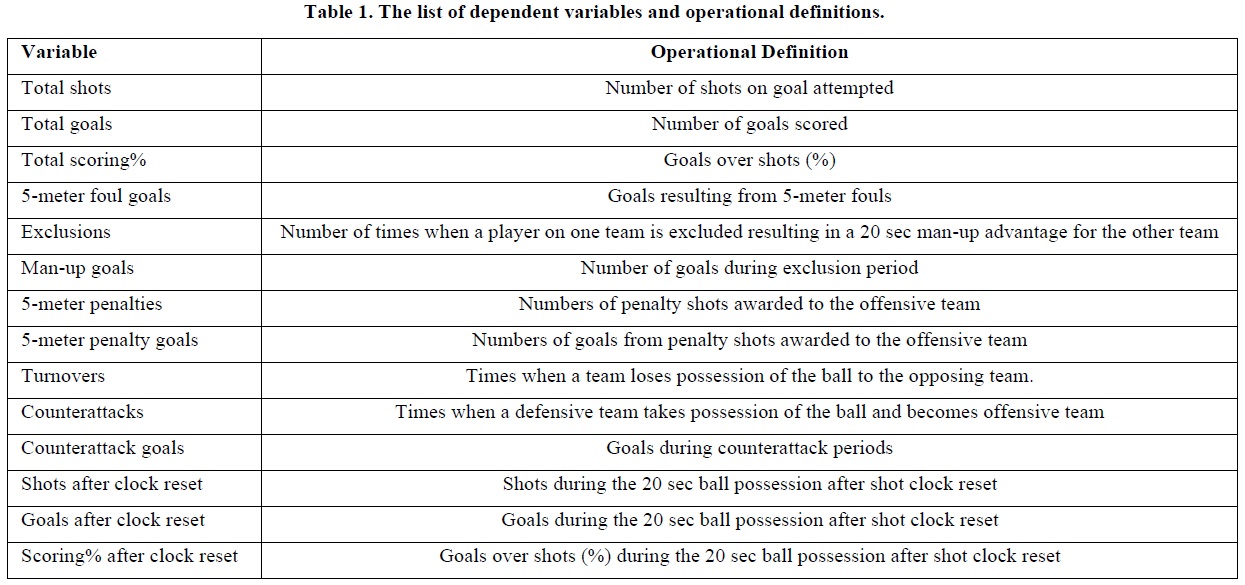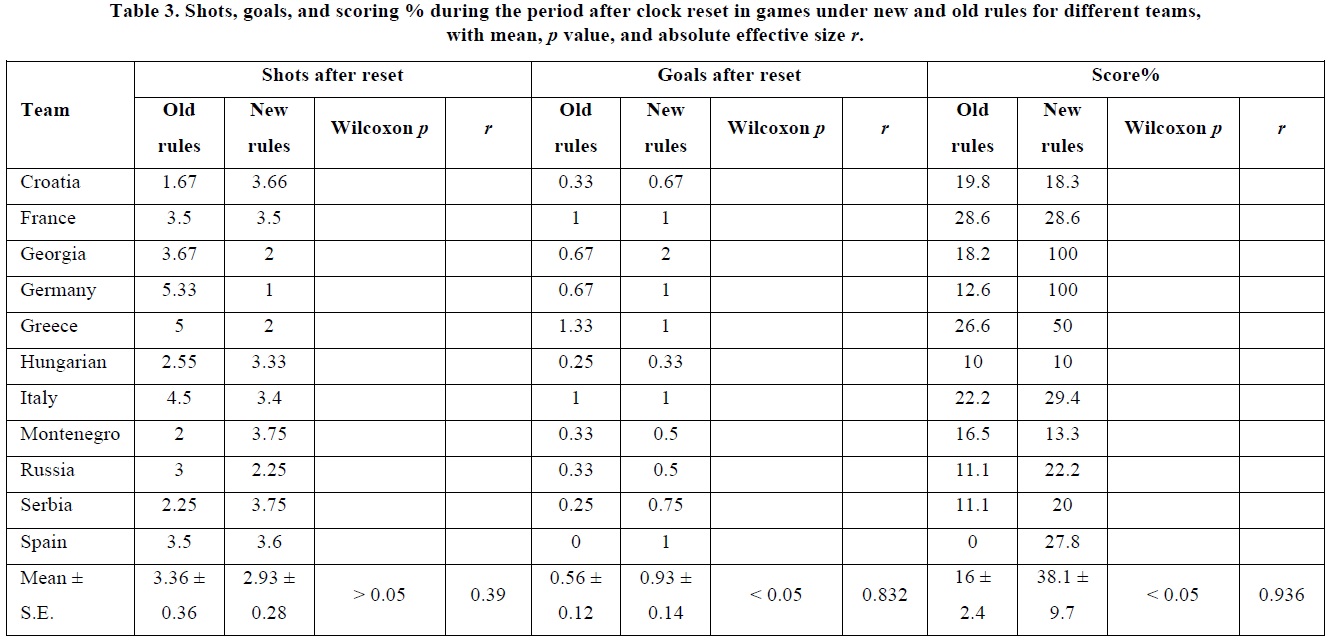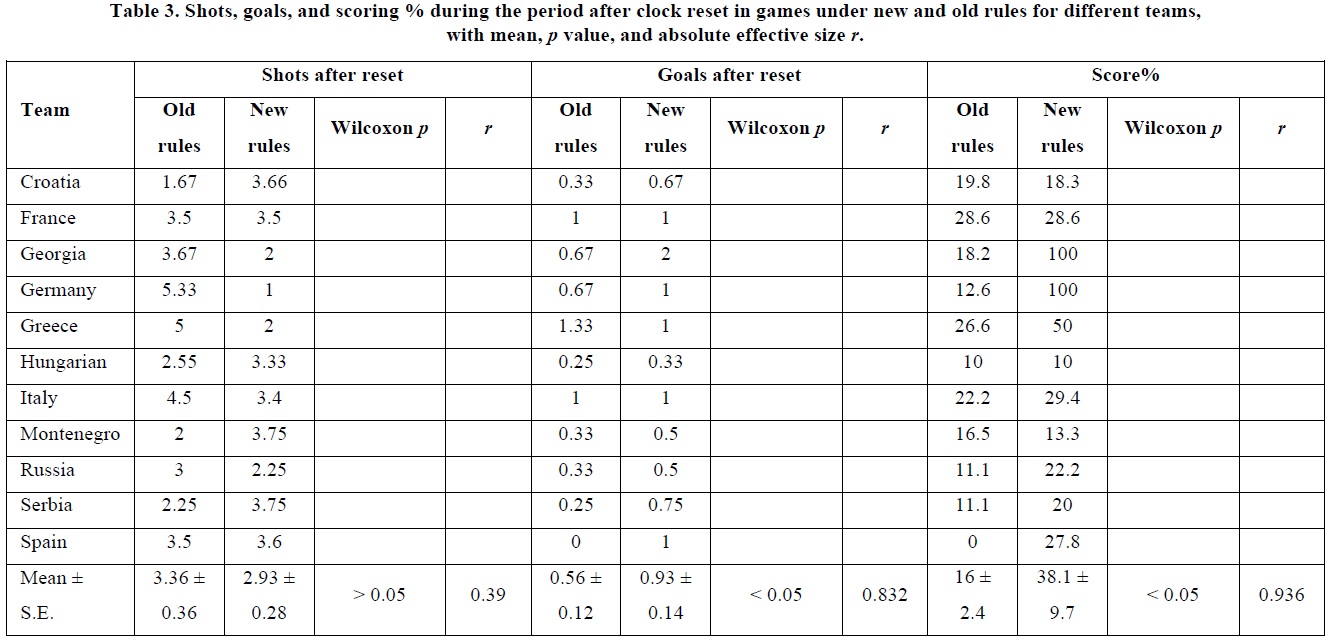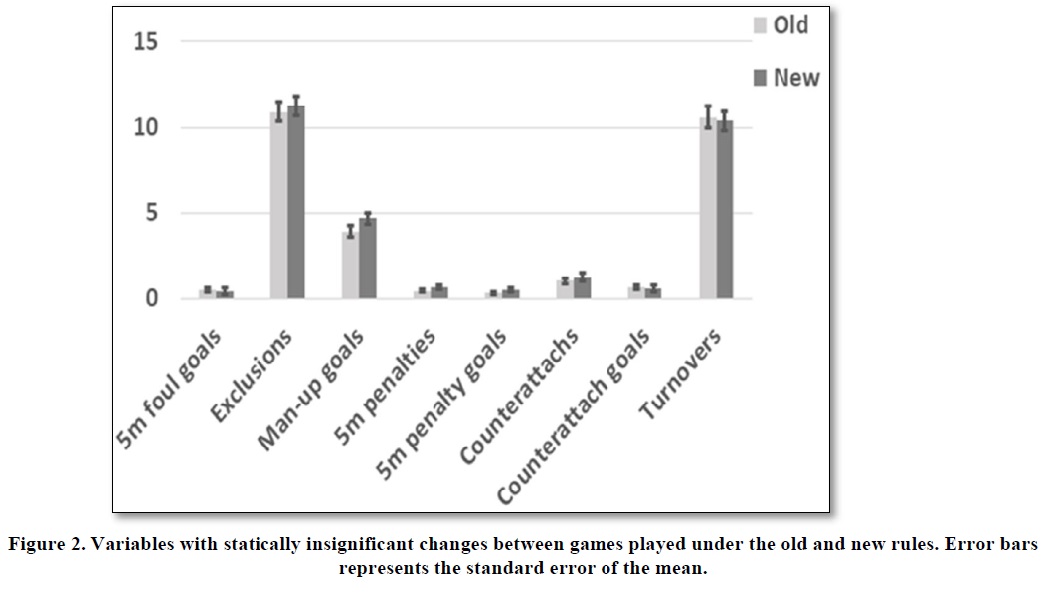-
Publish Your Research/Review Articles in our High Quality Journal for just USD $99*+Taxes( *T&C Apply)
Offer Ends On
Mark Li*, John Belov and James Graham
Corresponding Author: Mark Li, Great Neck North School, Great Neck, NY 11021, USA.
Received: September 06, 2022 ; Revised: October 04, 2022 ; Accepted: October 07, 2022 ; Available Online: October 18, 2022
Citation:
Copyrights:
Views & Citations
Likes & Shares
ABSTRACT
Water polo has recently encountered extensive challenges, including possible banishment from the Olympics. To meet these challenges, major rule changes have been implemented. The impact of FINA 2018 rule changes on game dynamics were analyzed by comparing men’s World Championships in 2017 and 2019. There is a significant increase in both shots, goals and score effectiveness, likely a result of the new FINA 2018 rule that has reduced possession time after clock reset from 30 to 20 sec. These findings are in line with FINA’s intention to make water polo a more dynamic and spectacle sport.
Keywords: Water polo, Rule changes, Impact, Game dynamics, Performance, FINA 2018
INTRODUCTION
Water polo is regulated by a set of complex regulations and rules that have controlled game play and influenced game dynamics and appearance [1,2]. Given its nature as a sport played in the water, water polo is relatively slow in players’ movement across the field, limited in techniques/tactics visible above the water, and therefore less appealing and engaging [3,4]. Since its beginning as the first team sport at the Olympic Games in Paris in 1900, water polo has gone through different phases of transformation yet recently confronted unprecedented difficulties mostly related to the change of audiences’ preference and remarkable competition among modern world sports. Water polo is losing its fan base, media coverage, global market, and has recently been threatened with banishment from the Olympics [5]. In response to the severe challenges, Fédération Internationale de Natation (FINA),the governing body of water polo, has revised its game regulations in order to enhance the game dynamics by fastening pace of the game and encouraging more offensive situation, both of which hopefully can generate higher goal counts, less predictability and a more vibrant, spectacular and engaging sport [6].
The significant FINA rule changes in the last twenty years have consistently shaped certain features of the water polo gameplay, as demonstrated by an evolving body of literature in sport sciences research [2,7-14]. These alternations in gameplay include increments in penalty goals, total goals; throw attempts and throws from peripheral positions. In addition, there is longer and faster swimming which is balanced by a shorter duration of physical contact. For example, in a longitudinal study of Olympics water polo matches since 1936, Madera [2] showed an increase in the number of total goals, winners’ goals, losers’ goals and goals per minute when FINA reduced possession time from 45 to 35 sec in 1977 and then from 35 to 30 sec in 2005. This result strongly indicated that the progressively shortened possession time has boosted game dynamics and competitiveness [2]. Even though current studies showed that majority of the resulted alternations in gameplay are in line with FINA’s intention to significantly improve energy and attractiveness of water polo, other transformations in gameplay are more complicated and sometimes in the opposite direction of the original intention of FINA rule modification [13,14].
In December 2018, the current FINA 2018 rule changes were approved in the FINA Extraordinary Congress to further meet the latest challenges in water polo sport [15-18]. Among the major FINA 2018 rule changes is a further reduction of possession time from 30 sec (FINA 2005 rule) to 20 sec after the following occasions: a) a corner throw, b) an exclusion and c) a rebound after a shot which does not cause change of possession. Other modified rules include 1) reducing the number of timeouts from one per quarter to two per game, 2) allowing the ball to immediately be put in play after a foul outside 6 meters or when taking a corner throw, 3) allowing free throws from the location of the ball and 4) allowing goalies to move past the center pool line. These functional rules were changed to decrease static duration and enhance game excitement. In addition to the modifications in functional rules discussed above, FINA 2018 also changed the following structural rules: 1) reducing the half time length from 5 minutes to 3 minutes and 2) expanding the substitution area from the goal line to the center pool line to allow “flying substitution”. These two changes in structural rules were made to further shorten the total duration of the game and cut down the static time used for substitution.
Given that the first official international match played under the new regulation was in April 2019, there have been only three published articles studying the impact of the FINA 2018 rule change. Based on an opinion article by Lozovina and Lozovina, the FINA 2018 rule changes did not significantly improve game attractiveness and were essentially considered as “cosmetic contributions” [6]. From a different approach using decision-tree method, Saavedra [19] investigated the 18th World Championship (July 2019) to identify variables that can differentiate between winning teams and losing teams [19]. Winning teams were found to have significantly increased their throw effectiveness under the new FINA 2018 regulations, while losing teams have not. The pivotal role of throw effectiveness became prominent more than it was before the FINA 2018 rule change. Lastly, Argudo [10] studied the 34th European Championship (January 2020) which became the last major water polo match before the following matches, including the 2020 Tokyo Summer Olympics, were either canceled or postponed due to the COVID-19 pandemic. Approximately 2500 shots from two male European Championships, one before (2006) and one after (2020) the FINA 2018 rule changes, were characterized and compared under different situational frameworks. The study showed fewer shots during counterattacks while there was remarkably increased number of shots during power play situations [20]. In light of the above findings, the goal of our study is to further analyze the influence of the FINA 2018 rule changes on game dynamics.
MATERIAL AND METHODS
Samples
Data were obtained from the publicly available YouTube channel “Europe Aquatics” which contains the official video broadcast recording of the FINA World Championships of 2017 and 2019 (before and after the FINA 2018 rule changes, respectively). A total of 40matches (20 from 2017 tournament and 20 from 2019 tournament) were performed by 10 men’s teams that participate in both tournaments were chosen. The teams included in the study are Croatia (3/4), France (2/2), Georgia (3/3), Germany (3/2),Greece (3/2), Hungarian (4/3), Montenegro (3/4), Russia (3/4), Serbia (4/4), and Spain (4/5), with the numbers in para theses represent the number of matches in 2017 over the number of matches in 2019.Given that the data is public and that the event and its participants were of legal age and authorized, this study does not request institutional review board approval.
Variables
We analyzed each match individually to identify and quantify the variables for each included team. The characteristic of FINA rules (either new or old) under which the matches were played were chosen as independent variable. The match-related dependent variables are listed and described in Table 1.

Notational analysis
We analyzed each match individually to identify and quantify the match-dependent variables listed in Table 1 for each team.
Rater reliability
To evaluate the reliability of the coding process, we assessed intra and inter rater reliability (Table 2). For intra-rater reliability, the same coder was required to code all the matches were twice, separated by an interim of four weeks. To ensure variable agreement between two coders (ML and JB), we performed inter-rater reliability. The intra- and inter-rater reliability were high with ICC of 0.989 (Confidence interval 0.976-0.997) for variable counts.
Statistical analysis
All the variables were calculated as average per game for each individual team. Due to violation of normality and small sample size, difference in match characteristics between the new rules and the old rules were assessed using the Wilcoxon signed rank test and effect size r. Magnitudes of effect size were interpreted by r: 0.1-0.3 = small, 0.3-0.5 = medium, > 0.5 = large. Statistical significance was set at p< 0.05. Analyses were performed SPSS (version 22.0).
RESULTS
Under the new FINA 2018 rule, there were increases in the average total number of shots from 25.77 ± 0.57 to 28.3 ± 0.87(p< 0.05, r= 1.037) and goals from 8.06 ± 0.48 to 9.92 ± 0.46 (p< 0.05, r= 1.182), with a higher success rate from31.1 ± 1.5% to 35.1 ± 1.4% (p< 0.05, r = 0.807) per match (Figure 1 & Table 2).


Given that the major rule change in 2018 was the reduced possession time from 30 sec to 20 sec, we analyzed a subset of the three variables (shots, goals, and score %) during the period after clock reset. There were increases in goals from 0.56 ± 0.12 to 0.93 ± 0.14 (p < 0.05, r = 0.832) and scoring efficiency from 16 ± 2.4% to 38.1 ± 9.7% (p < 0.05, r = 0.936) associated with implementation of the new rules while the change in the number of shots after clock reset was statistically insignificant (Figure 1 & Table 3).

The other eight variables had statistically insignificant differences (p> 0.05) between the two rules (Figure 2).

DISCUSSION
The primary intent of the FINA 2018 rule changes is to enhance game dynamics. This aim has been partially achieved, as indicated by our study’s primary finding of significant augmentation in the number of shots (2.5 per game), goals (1.9 per game) and score % (4%) when the game was played under the new rules vs. the old rules. This result is likely attributed to the new rule of changing possessing time from 30 sec to 20 sec after clock reset following a corner throw, a rebound or exclusion. Retrospectively, water polo possession time has been progressively decreased from 45 sec to 35 sec in 1977 and to 30 sec in 2005. After the FINA 2005 rule modification, several studies have shown that the FINA 2005 new rule was associated with increases in the number of goals (total goals, winners’ goals, losers’ goals, and goals per minute), acceleration of offensive play, and more frequent exchange of possession [2,21,22]. This phenomenon was also found in other sports such as basketball after the shortening of possession time [23].
The study’s primary observation of significant increases in total shot and goals is supported by our secondary finding that the subset of goals after shot clock reset escalated considerably from a mean of 0.56 ± 0.41 per game in 2017 games to 0.93 ± 0.48 in 2019 games, with p < 0.05 and r = 0.832.Although the absolute increase of 0.37 in the subset of goals after clock reset is statistically significant, it is relatively minor when compared to the absolute upturn of 1.9total goals per game (from 8.06 ± 1.61 to 9.92 ± 1.54).The finding suggests possible confounding factors such as influence of psychological pressure or urgency among the players to accelerate the game due to the reduced possession time after reset from 30 sec to 20 sec. Another explanation is the presence of unknown factors that were collected given the limited scope of variables currently included and analyzed in the study.
Another finding of the study, even though paradoxical, is the considerable increase in the subset of score effectiveness after clock reset. It increased from 16% with the 30 sec possessing time to 38% with the 20 sec possessing time(p < 0.05 and r = 0.936), in contrast to the relatively small yet statistically significant increase in score effectiveness for the whole game (from 31% to 35%, p < 0.05 and r = 0.807). We speculate that water polo players were well prepared for the FINA 2018 rule change with effective tactics to score despite the time pressure after the shot clock reset. In the literature, the role of shot effectiveness in water polo was investigated. It is the most critical variable to differentiate between winning and losing teams in the study by Escalante [21]. Under the new FINA 2018 rule, the key role of shot effectiveness became more prominent [19]. In future studies, we will further analyze the role of shot effectiveness in terms of location and situational frame work to gain more information.
Our study did not identify changes in several other variables when possession times after clock resets were decreased from 30 sec to 20 sec. For example, the number of possession turnover and counterattack remained to be approximately 10 per game and 1 per game, respectively. Historically, when FINA 2005 rule shortened possessing time from 45 sec to 30 sec, Escalante et al showed a speeding up of offensive play and more frequent exchange of possession in addition to an increase in total shots/goals [21,22]. Another negative finding in the current study is the number of penalty shots. This is not unexpected as the new FINA 2018 rule did not include any changes involving penalty shot. In matches after 2005 when penalty shot distance of 4 meters was extended to 5 meters, study showed that the longer distance for penalty resulted in a surge of 3-fold in the total number of penalty shots yet a similar success rate [10].
In this study, one major limitation is the relatively shortlist of collected variables that were solely based on the official video broadcast recording publicly available in YouTube, rather than a combination of video broadcast and on-site video camera recording. In addition, with the lack of notational analysis software, we were not able to perform analysis on as many variables as other studies have done. For example, Saavedra [19] were able to analyze the 18th World Championships 2019 database that included a panel of 25 variables containing temporal information or field information on shots/goals, fouls, and goalkeeper-block [19]. Furthermore, our study may be limited due to the relatively small sample size. After elimination of games played by teams that have not participated in both World Championships 2017 and 2019, a total of 40 matches (20 from 2017 tournament and 20 from 2019 tournament) were included, consisting of approximately half of all the games have been played. The relatively limited range of variables and small sample size in our study prevented more sophisticated data analysis.
Future investigations following this preliminary study is underway to include more matches, more technical details from different data resources and more powerful notational analysis software. Under the current situation where nearly all major water polo matches were either postponed or cancelled due to the COVID-19 pandemic, further research on the effect of FINA 2018 rule changes may become very challenging. Moreover, coaches may have voluntarily or involuntarily reformed training intensity and schedule during the COVID-19 pandemic. This change in training has presented a possible confounding factor for future analysis. Lastly, the pandemic may have further enhanced the disparity between elite teams and lower level teams in terms of adaptation to the new FINA 2018 rule. This is an interesting area for future research, in light of a pre-pandemic finding that different teams may have adapted and responded differently to rule changes, with top teams adjusted them much quicker [21]. Notwithstanding the above challenges, the water polo community is in need of further data-driven studies on the effects of the FINA 2018 rule changes. Players and coaches will benefit from applying the research results to developing new technical/tactical actions and conceptualizing of novel game strategies. With the help of quantitative information that provides precise target for future revisions of the current rules, FINA’s blueprint of transforming water polo into a more energetic and engaging sport will be more achievable.
CONCLUSION
The significant increase in both shots and goals is likely a result of the new FINA 2018 rule that has reduced possession time from 30 sec to 20 sec after clock reset. These findings, although preliminary given the scope of the study, suggest that the effects of the current modification are in the same direction toward a more vibrant and spectacular water polo sport as FINA initially intended.
Ethics Approval and Consent to Participate: Not applicable.
Human and Animal Rights: No animals/humans were used for studies that are the basis of this research.
Consent for Publication: Not applicable.
Funding: None.
Availability of Data and Materials: Not applicable.
Conflict of Interest: None.
Acknowledgements: None declared.
REFERENCES
No Files Found
Share Your Publication :